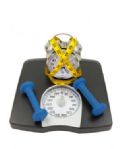|
Getting strong on the major lifts—the bench, squat and deadlift—is awesome for total body strength and longevity, there's no doubt about that. The temptation to pick up heavy dumbbells and get to work can be overwhelming, especially if you're someone who compares their progress to others in the weight room. What happens too often, though, is that beginners prioritize those individual lifts to start and ignore the proper exercise progressions that get them stronger and give them the tools to safely train the big lifts and ultimately maximize their results. Exercise and the ability to train hard not only now, but for the long-term, while keeping yourself injury-free should be a priority for every single person who steps foot into the gym. To do that successfully, it's important to understand that getting stronger isn't just about adding weight to the barbell or doing a specific exercise with heavy dumbbells. Rather, it's about using the appropriate variations that fit you and your current fitness level and making consistent progress from session to session. Whether that means moving better, implementing different exercise variations, challenging yourself by using different tempos, adjusting rest times, using other various intensity techniques or, ultimately, adding weight to the bar, the focus needs to be on getting better and stronger than you previously were. When trying to decide where to start, there are unlimited exercise programs from which to choose, trainers with different exercise ideologies and exercise equipment options at your disposal. With so many variables, it's no wonder many people feel overwhelmed and confused about how to get started. Lucky for you, the best piece of equipment and one that every single one of us has access to is our own body. Using Move Your BodyTo understand how to get strong, you must first understand that there are six foundational movement patterns that every person on earth should be practicing. It doesn't matter if your goal is to get stronger, lose weight, pack on muscle or just feel and move better, these six movements need to be the cornerstone of your training. These movements include the squat, lunge, hinge, push, pull and carry. Each one is a basic human movement that everyone develops from infancy towards adulthood. What tends to happen as we age, though, is some of those As stated above, when trying to build a solid foundation of strength, the best place to start is with your own body. Emphasizing movement quality instead of being a slave to the dogmatic approach of force-feeding exercises and always looking to lift heavier will streamline your goal of long-term success, allowing you to train hard and stay injury-free. Improving your relative strength and Most people overlook this idea because they believe bodyweight exercises are "too easy" or less challenging. If this is something you have also thought yourself, there's a good chance you simply aren't choosing challenging variations to elicit a good training response. There are unlimited variations of bodyweight exercises that you can do to make your workout harder or easier depending on your fitness level. Mastering the Six Foundational MovementsTo start building long-term strength that will transfer over into future big lifts, try these bodyweight exercises for each movement pattern. Each one of these will emphasize the movement quality we are looking for, as well as provide a challenge to build a solid strength foundation: Squat:
While it might not be everyone's goal to lift heavy weights, mastering each foundational movement pattern with bodyweight first is a must. Not only will you build strength, but you will also achieve longevity and improve quality of life as a result. Now, who says bodyweight work is boring again? **Note: It is understood that there |





.png)
